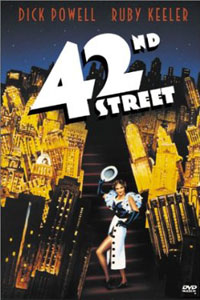
42nd STREET
US, 1933, 89 minutes, Black and white.
Warner Baxter, Bebe Daniels, Dick Powell, Ruby Keeler, George Brent, Una Merkel, Ginger Rogers.
Directed by Lloyd Bacon.
42nd Street is described by most books as the definitive backstage musical. It still stands up well when it is considered that it was made in 1933. Warner Baxter is interesting as the ailing director who has to cast his musical and has Bebe Daniels at hand. She breaks her leg but, fortunately, there are plenty of dancers on standby - hardboiled Ginger Rogers and attractive Ruby Keeler. Heroic Ginger steps back for Ruby and the show is a success. Dick Powell is the singing hero. This conventional material has been used innumerable times.
It was probably used to best advantage by Ken Russell and was incorporated almost as a whole into his story and presentation of The Boyfriend in 1971. Twiggy has the Ruby Keeler role and Glenda Jackson a guest part as the dancer who breaks her leg. Busby Berkley's musical numbers are, of course, famous and fit in with the many films that he choreographed at this time eg. Footlight Parade. Enjoyable and of great historic interest.
1. The film as an example of early sound, sound techniques, acting, screenplay etc.? How well does it stand up now?
2. The example of the 30s musical, background story, stage, the Busby Berkeley staging of musicals etc.?
3. Audience presuppositions about the world of entertainment, musicals, people good and bad, the cliches of later films, success etc. How well used were these?
4. How credible was the basic situation? The background of stage in the 30s, business, the Depression, atmosphere?
5. The detailing of the world of theatre, money deals, stars and auditions, ambitions and success? How conventional, the material, how well-explored?
6. The character of Julian Marsh, his background in the theatre, his self-importance, his illness? His wanting success, his manner of driving people? How well delineated as a character?
7. The presentation of Peggy, an attractive heroine, her shyness in arriving for the audition, the help from Billy, the talking with the other show girls, the details of presenting her rehearsal, her ability as a dancer, the sudden audition to be the leading lady, the build-up to her fears, her success? Final happiness? The American dream?
8. How attractive was the original star, her skill, her being related to the patron and his investment in the show, her secret relationship with Pat Denning? The background of threats, the use of gangsters? The importance of the accident to her uncle? Her initial jealousy of Peggy, the importance of her pep talk in urging her to be a success and contrasting the possibilities of her happiness?
9. The film's presentation of the world of the showgirls and the dancers, their ruses to get into the show, Ginger Rogers as the star who almost made it yet nobly gave way to Peggy; the humour of this character?
10. The importance of the show and the film's devoting so much attention to it, the choreography, the costumes, the Berkeley style with the multiple sets, the lavish dances and pageantry, the lyrics of the song?
11. How interesting an example of an early presentation of the Hollywood dream of theatrical success? The American fairy tale?